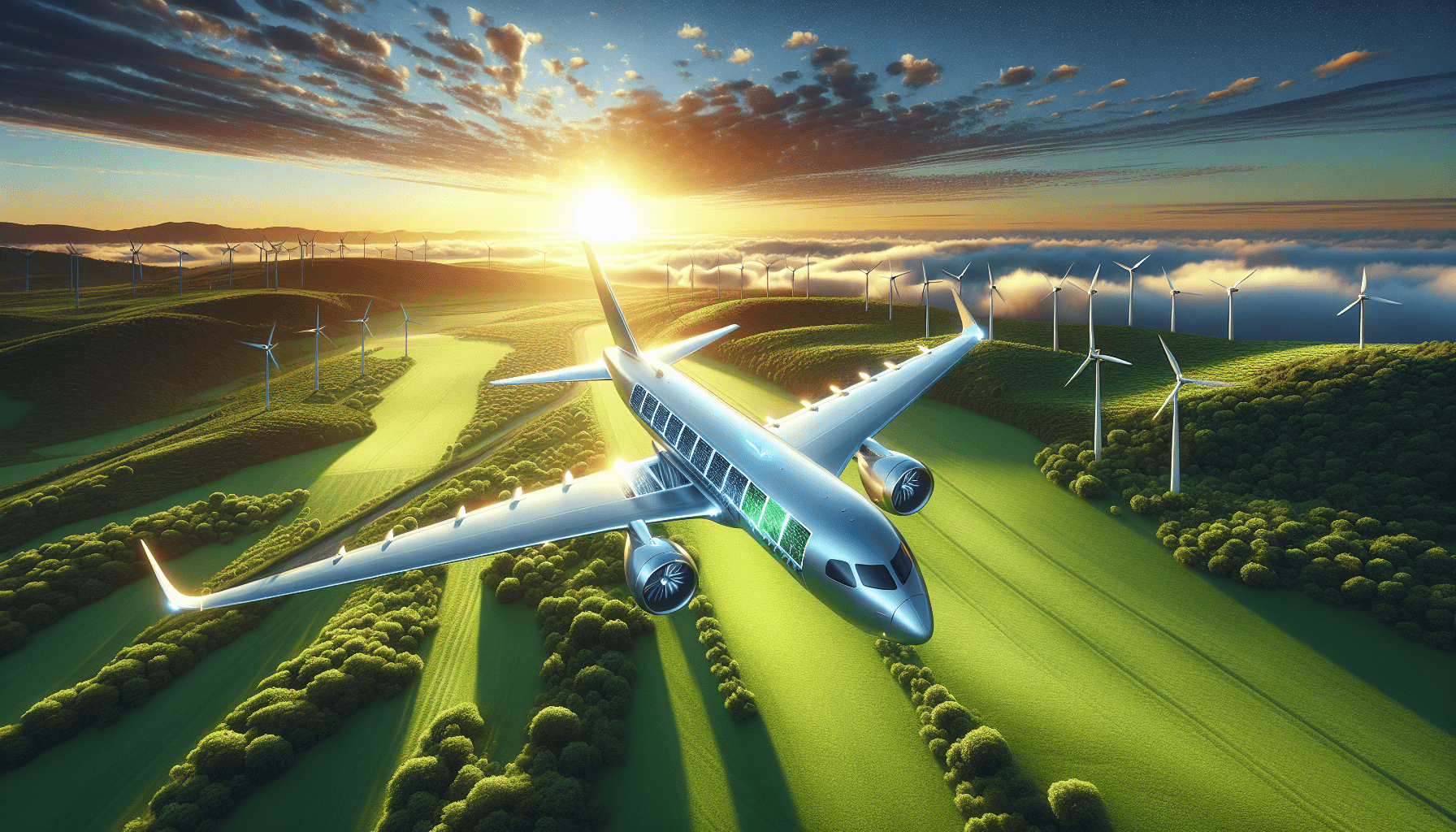Kitsch Spray Bottle for Hair - Continuous Water Mister with Ultra Fine Mist for Hairstyling, Barbers, Salons, Cleaning, Plants, Versatile Spray Bottles - Made from Recycled Plastic - Terracotta, 5 oz
$7.19 (as of November 22, 2024 15:26 GMT +00:00 - More infoProduct prices and availability are accurate as of the date/time indicated and are subject to change. Any price and availability information displayed on [relevant Amazon Site(s), as applicable] at the time of purchase will apply to the purchase of this product.)Have you ever wondered what the future holds for air travel in terms of sustainability and eco-friendliness? The Federal Aviation Administration (FAA) is making strides in ensuring that our skies remain blue and our carbon footprint is reduced, all while keeping the benefits of air travel intact. How? By awarding a significant $291 million in grants toward the development of sustainable aviation fuel (SAF) and other low-emission aviation technologies.

Shop These Accessories for a Comfortable Trip
FAST Grants: A Game Changer for Sustainable Aviation
The FAA’s initiative, known as the Fueling Aviation’s Sustainable Transition (FAST) grants, is part of the broader Inflation Reduction Act. These grants aim to support the aviation industry’s goal of achieving net-zero greenhouse emissions by 2050. With such substantial backing, it’s clear that the FAA is committed to fostering cleaner technology and ensuring the sustainability of aviation for the foreseeable future.
Allocation of Funds: Where Is the Money Going?
So, where exactly is this $291 million headed? The breakdown of the funds gives insight into the FAA’s targeted approach:
- $244.5 million is allocated to 22 projects focused on blending, producing, storing, or transporting SAF.
- $46.5 million is directed toward 14 projects developing or demonstrating low-emission aviation technologies.
Sustainable Aviation Fuel (SAF): The Future Is Here
SAFs are jet fuels derived from renewable sources and engineered to produce lower carbon emissions. The best part? They can be used in today’s aircraft without major modifications. This is a vital step because it bridges the gap between current operations and future, more sustainable practices.
Low-Emission Technologies: Beyond Just Fuels
The remaining funds are earmarked for technological advancements designed to enhance aircraft fuel efficiency, reduce carbon output, and integrate more SAF. This could involve new engine designs, lightweight materials, and more efficient flight operation techniques.
The Bigger Picture: Sustainability Goals and Global Leadership
U.S. Secretary of Transportation Pete Buttigieg has emphasized that these grants are more than just financial aid; they are crucial elements in the journey toward decarbonizing aviation. By investing in these projects, the FAA aims to put the world on a path toward achieving the mid-century target of net-zero emissions while also fostering domestic economic growth and maintaining the U.S. as a leader in global aviation.
International and Domestic Impact
According to Laurence Wildgoose, FAA Assistant Administrator for Policy, International Affairs, and Environment, the projects funded are instrumental in advancing both environmental and economic sustainability goals. All grant recipients are U.S.-based and are committed to aligning their operations with the U.S. Aviation Climate Action Plan, ensuring that the aviation sector moves toward achieving net-zero greenhouse gas emissions.
Current State of Air Travel: The Need for Change
Here’s something that often gets overlooked: For all its conveniences, air travel is a significant contributor to global carbon emissions. Here’s a look at why this new funding is so essential:
Carbon Footprint of Commercial Aviation
Commercial aircraft are responsible for roughly 2.5% of global carbon emissions, a number that’s growing annually as air travel becomes more accessible and widespread. Without intervention, this number could rise, further exacerbating climate change issues.
The Biden Administration’s Role
Part of President Biden’s Investing in America Agenda, these initiatives demonstrate a broad commitment to tackling climate change. This agenda aims to make substantial investments in cleaner technologies and other sustainable practices across multiple sectors, not just aviation.
What Does This Mean for Travelers?
If you’re someone who loves to travel but is concerned about your environmental impact, these developments should come as welcome news. The advancements funded by these grants mean that air travel can become more sustainable without compromising on comfort or convenience.
Immediate vs. Long-term Benefits
In the short term, expect to see incremental improvements in fuel efficiency and fewer emissions. Over the long haul, these initiatives could revolutionize air travel, making it significantly cleaner and more eco-friendly.
What to Look Out For
Keep an eye out for airlines that announce new commitments to sustainability initiatives, especially those that are grant recipients. These airlines are likely to be early adopters of SAF and other low-emission technologies, offering travelers more responsible choices.

Shop These Accessories for a Comfortable Trip
The Role of Industry Stakeholders
The aviation industry isn’t going at this alone. Various stakeholders, from airlines to fuel producers, are involved in making sustainable aviation a reality.
Collaboration Between Airlines and Fuel Producers
Airlines and sustainable fuel producers will have to work hand-in-hand to meet the goals set by the FAA and other regulatory bodies. Funding will likely facilitate partnerships aimed at accelerating the production and adoption of SAF.
Investment in Research and Development
Much of the allocated $291 million will likely go toward R&D to develop not just fuels but a range of technologies aimed at reducing carbon emissions. Innovations in engine efficiency, aerodynamics, and flight operation practices are just a few areas ripe for exploration.
The Tech Behind Low-Emission Aviation
What kinds of tech could we see emerging from this funding? Let’s dive into the exciting possibilities.
Engine Innovations
Expect to see advancements in engine technology that improve fuel efficiency and reduce emissions. Electric and hybrid-electric propulsion systems could also become more viable for commercial aviation.
Aerodynamic Developments
Changes in aircraft design, such as wing shapes and body structures, could lead to more fuel-efficient flights. Blended-wing body designs, like those being developed by companies such as JetZero, are promising areas of research.
Operational Efficiencies
From optimized flight paths to better air traffic management, operational changes can significantly reduce the carbon footprint of air travel. These are areas where even small improvements can lead to substantial benefits.
Real-world Examples of Funded Projects
Let’s take a look at some specific projects that have received funding and what they aim to achieve.
| Project | Funding Amount | Focus Area | Goals |
|---|---|---|---|
| Green Energy Fuels | $10 million | SAF Production | Increase capacity for producing renewable jet fuels |
| AeroTech Innovations | $5 million | Low-Emission Technologies | Develop lightweight materials for aircraft |
| FlightPath Solutions | $3 million | Operational Efficiency | Optimize flight paths to reduce fuel consumption |
These projects give us a glimpse into the varied ways the aviation industry is tackling the challenge of sustainability.
Public and Private Sector Involvement
It’s not just government bodies and airlines that are invested in this transition. Private sector players, including investors and tech companies, are also getting involved.
Venture Capital and Startups
The promise of sustainable aviation fuels and technologies is attracting venture capital. Startups focusing on green aviation tech are likely to see increased funding, fostering a culture of innovation and competition.
Collaboration with Universities
Research institutions and universities will play a critical role in advancing the technologies required for sustainable aviation. Expect to see collaborative projects that combine academic research with industry needs.
The Road Ahead: Challenges and Opportunities
While the path to sustainable aviation is promising, it’s not without challenges. However, each challenge also presents a unique opportunity for innovation and progress.
Technical and Regulatory Hurdles
Developing new technologies is one thing; getting them certified and standardized for commercial use is another. Both technical performance and regulatory compliance will be critical.
Scaling Up Production
Producing SAFs at a scale that makes them economically viable is another significant challenge. This will require advancements in production technologies and infrastructure.
Cost Considerations
While SAFs and new technologies promise long-term savings and environmental benefits, initial costs can be high. There will need to be a balance between economic viability and sustainability.
The Global Perspective
While these FAA grants focus on U.S.-based projects, the implications are global. As the U.S. makes advancements, these technologies and practices can be adopted worldwide, setting global standards for sustainable aviation.
International Collaboration
Expect to see more international cooperation in the realm of sustainable aviation. Countries will need to work together to create a cohesive and effective approach to reducing aviation emissions.
Setting Global Standards
As a leader in aviation, the U.S. has the opportunity to set standards that can be adopted globally. This includes safety standards, technological benchmarks, and best practices for sustainable aviation.
Conclusion: Taking to the Skies Sustainably
In summary, the FAA’s $291 million in FAST grants mark a significant milestone in the journey toward sustainable aviation. By focusing on both sustainable aviation fuels and low-emission technologies, the initiative promises to bring substantial changes to the industry. This not only benefits the environment but also sets the stage for economic growth and maintains the U.S.’s leadership in global aviation.
For travelers, this means cleaner skies without sacrificing the freedom and convenience of air travel. For the industry, it represents a future where sustainability and profitability go hand-in-hand. As these projects unfold, we can look forward to an innovative, eco-friendly future in aviation.
Shop These Accessories for a Comfortable Trip






